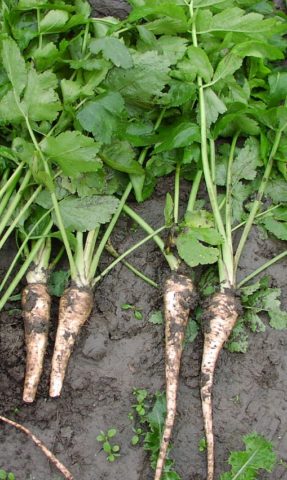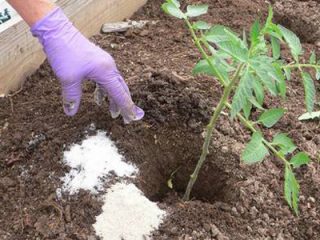Content
- 1 What does parsnip look like and what kind of vegetable is it (write a description)
- 2 Composition and nutritional value of parsnip
- 3 What are the benefits of parsnips?
- 4 Useful properties of the parsnip plant
- 5 Use of parsnip vegetable in folk medicine
- 6 Use of parsnips in cooking
- 7 The use of root vegetables in cosmetology
- 8 Restrictions and contraindications
- 9 Conclusion
Parsnip is a herbaceous plant from the Apiaceae family. The garden vegetable was used as a medicine in ancient times. Decoctions were prepared from it and given to sick people with colds. Soon the temperature dropped, the patient regained strength and made a full recovery.
In Rus' and Tsarist Russia, Mediterranean root crops were planted in fields and garden plots. Parsnips were grown on a large scale in the famous garden of Tsar Alexei Mikhailovich. The royal family loved this vegetable for its sweet taste and spicy aroma.
What does parsnip look like and what kind of vegetable is it (write a description)
Wild parsnips grow in Europe, the fruits of which are extremely toxic, and numerous photographs show traces of burns from the leaves.
The parsnip root in the photo is white or yellowish in color and expands towards the base.
The vegetable, also called field borscht, white root or popovnik, in appearance resembles a carrot with an elongated root shape, long stems and small carved leaves. From the photo, a significant difference in the color of the plants becomes obvious: the root of the parsnip is white.
The stems of the plant are elongated, ribbed, and can reach 200 cm. Its leaves are small and feathery. Parsnips bloom at the end of July with yellow flowers resembling umbrellas in shape. It blooms with small yellowish flowers, which are shaped like the dome of an umbrella.
In the south of Russia, Kazakhstan, Uzbekistan and other countries of Central Asia, parsnips are grown as a garden crop, the fruits of which are used in cooking, medicine and cosmetology.
What does parsnip taste like?
Not a single festive photo of a table for Christmas in England can be imagined without such a vegetable as parsnip. It is added when stewing vegetables and preparing meat dishes.
Similar in taste to parsley or celery stalks, the richly spicy vegetable leaves a sweet aftertaste. Popovnik is distinguished by a pleasant aroma.
The taste and smell of the white root vegetable has a stimulating effect on the human body. Dishes with it act as an aphrodisiac.
Composition and nutritional value of parsnip
The parsnip root vegetable is incredibly rich in nutrients. It contains:
- dietary fiber with essential oil;
- carotenoids;
- vitamins (C, PP, group B);
- minerals (potassium, calcium, phosphorus, magnesium, iron, etc.).
In terms of nutritional value and the presence of fast carbohydrates, field borscht is a leader among other vegetables.
100 g of vegetable contains:
- proteins – 1.45 g;
- fats – 0.55 g;
- carbohydrates – 9.3 g.
The glycemic index (GI) of the root vegetable is 85.
Parsnips are low-calorie foods. Its total calorie content is 47 kcal. Nutritionists recommend including the spicy vegetable in the diet of overweight people.
With a sufficiently high GI, the white root does not provoke the accumulation of fat mass. And, on the contrary, it contains easily digestible carbohydrates, which are useful during periods of active exercise and intensive weight loss. During long walks or immediately after the gym, the root increases blood glucose levels to replenish energy.
What are the benefits of parsnips?
Parsnip root has unique beneficial properties and has a number of contraindications.
The vegetable contains the optimal ratio of minerals and vitamins beneficial to the body. Calcium, phosphorus and magnesium help maintain bone health. Calcium present in the composition plays an important role in the transmission of nerve impulses and muscle contractions. Potassium, which is also present in the vegetable, promotes better blood circulation, and magnesium improves heart function.
Due to the high content of vitamin C, parsnips have antipyretic and anti-inflammatory effects. In Rus', a spicy drink was prepared for those who were sick, which had medicinal properties. The decoction contained not only herbs, but also the Mediterranean parsnip root.
In the modern world, medicines are produced from the root extract - Pastinacin, Beroxan and Eupiglin.
Pastinacin is used as an antispasmodic for neuroses, irritations and spasms of the gastrointestinal tract, and for diseases of the genitourinary system and kidneys.
Beroxan (Eupiglin) increases the skin's sensitivity to ultraviolet rays, so it is prescribed for psoriasis, for the treatment of vitiligo, alopecia and other diseases.
Medicines containing fruit and seed extracts are effective in treating many other diseases:
- bronchitis, pneumonia, turbeculosis;
- various neuroses and disorders of the nervous system;
- arrhythmias and other cardiovascular diseases.
For men
A decoction of the root is very beneficial for men's health. The vegetable has a healing effect for prostatitis, pyelonephritis and other inflammatory urological diseases.
Thanks to the mild diuretic effect of consuming the root vegetable, sand is washed out of the kidneys and stones are dissolved.
After medical intervention on the genitourinary organs, doctors recommend adding time-tested folk recipes to drug treatment during the rehabilitation period. A drink made from this healing vegetable has an antispasmodic and analgesic effect.
Parsnips are a natural aphrodisiac. The essential oils contained in the root vegetable have a stimulating effect and enhance male power. Regular consumption of this vegetable increases sexual desire and libido.
For women
White root is an excellent immunomodulator. Eating it stimulates the body to recover quickly during prolonged colds.
The root vegetable is beneficial for women at any age. Its medicinal properties prevent heart disease, liver and kidney disorders, and normalize blood pressure and blood sugar levels.
White root is good for pregnant women because it reduces the risk of birth defects in newborns.
Useful properties of the parsnip plant
With proper use of parsnip root and leaves, this unique plant with its beneficial properties can relieve spasms, pain and have a tonic effect on the body.
The small leaves of the root vegetable contain twice as many vitamins and microelements as parsley or dill.
The spicy root helps improve digestion and strengthen the walls of blood vessels. It is used as a natural pain reliever and expectorant.
Other beneficial properties of the spicy vegetable are also known. In medicine, extracts are used for edema as a diuretic, for colds - for better sputum discharge, lowering high fever and increasing appetite.
Benefits of parsnip root
Parsnips have a weak diuretic and diaphoretic effect, remove excess water from the body well and relieve swelling of soft tissues.
In addition, the white root vegetable has an antipyretic effect. It effectively relieves fever and body aches, enhances appetite and digestion. From eating parsnips, those who are ill quickly recover and feel a surge of strength.
Essential oils of the root act as an aphrodisiac and have a stimulating effect on men: they improve libido and increase sexual desire.
Medicines from the spicy vegetable are used for nervous disorders and neuroses. It is also used for various gastrointestinal diseases as a homeopathic pain reliever.
White root has a strong tonic effect on the body, so many athletes include it in their daily diet to improve athletic performance.
The leaves and roots lower blood sugar levels, which is why parsnips are very beneficial for people with diabetes.
Vegetable juice neutralizes bad breath and helps maintain healthy gums.
Can you eat parsnip leaves?
Parsnip leaves can be used for food not only fresh, but also dried.
Green leaves are rich in vitamin C. In vegetable salads, the addition of plant greens adds a pleasant acidity.
When dried, all beneficial properties and aromas are preserved. Parsnip seasoning adds a spicy flavor to the dish.
Beneficial properties of parsnip seeds
In medicine, the roots, leaves and seeds of parsnip are used for health and benefit. This is a harmless natural raw material for medicines for various diseases:
- vascular and cardiac ailments;
- gastrointestinal diseases, etc.
If you rub the seeds of the root vegetable in your palms and inhale the fragrant aroma, then the essential oils will improve your mood and apathy will go away.
Use of parsnip vegetable in folk medicine
Unique recipes with parsnips have survived to this day.
To strengthen the immune system and increase the body's resistance to various diseases, you will need:
- sugar – 1 tbsp. l.;
- warm milk – 1 glass;
- parsnip juice – 30 – 50 ml.
Sugar is dissolved in parsnip juice and in a water bath and, stirring constantly, brought to thickening. Pour warm milk into the resulting mixture and mix. Drink the drink 30 minutes before meals twice a day.
In Rus' they used parsnip tincture to restore strength. The finely chopped root was poured with moonshine and left for 7 days in a dark place. Drink this drink one teaspoon before meals three times a day.
Use of parsnips in cooking
The root is used in cooking, both fresh and dried.
Fresh and dried root vegetables are ideal for vegetable soups. It gives the first dish a delicious spicy aroma.
Fresh leaves are added to various salads, and dry leaves are used as a seasoning for fish and meat. Parsnip root, like carrots, can be eaten whole.
In many countries, the root vegetable is subjected to heat treatment. Someone stews it with potatoes and mushrooms. It is boiled and grilled as a side dish. In Canada, puree is prepared from the boiled product.
The use of root vegetables in cosmetology
Since ancient times, parsnip essential oil and juice have been used to maintain beauty and youth. The extract was added to creams, masks, wraps and baths.
Parsnip juice maintains skin turgor, preventing the formation of wrinkles. Whitens age spots and evens out complexion.
Pimples, acne, enlarged pores, comedones - all of this can be treated with products that contain parsnip root extracts or leaf extracts.
In cold weather, a nourishing cream with spicy root vegetable extract saturates the skin with essential substances and provides moisture.
Parsnip essential oil is used to get rid of problem areas from stretch marks and cellulite.
Restrictions and contraindications
Before you start consuming parsnips for the benefit of your body, you should definitely consult with your doctor: if you have chronic diseases or food allergies, the vegetable should be completely avoided in order to minimize its possible harm.
Parsnips are contraindicated for children under 6 years of age. Elderly people over 60 years of age can use the spicy root with caution and in small quantities. At the same time, be sure to monitor the body’s reactions.If the pulse increases and blood pressure increases, the product is excluded from the diet.
In addition, people with acute gastrointestinal diseases and any inflammatory processes should not consume the root vegetable.
Parsnips are contraindicated for photodermatosis. This inflammation of the skin occurs due to acute sensitivity to sunlight. Parsnips contain phytooils - furocoumarins, which increase the skin's sensitivity to ultraviolet radiation.
People belonging to the 1st skin phototype - with light and thin, porcelain-like skin and blond hair - due to a low threshold of sensitivity to ultraviolet radiation, should use this product in food with caution and carefully select parsnip-based medications.
You need to be especially careful when handling the leaves of the plant. If the leaf comes into contact with wet skin, it can cause severe burns and long-lasting wounds.
The vegetable is strictly contraindicated during exacerbations of gastritis, pancreatitis, gastric ulcer, as well as in severe liver and kidney diseases.
Conclusion
Parsnip (field borscht, white root or popovnik) is a biennial garden plant, the root of which is used in cooking, medicine and cosmetology.
The tops and stem of popovnik are similar to carrots.
Root vegetables and greens, dried and fresh, are used in cooking. Parsnips are added as a seasoning to add flavor to a dish, as a preservative for vegetable preparations, or as one of the ingredients in a salad.
The beauty industry uses essential oils and juice to maintain youth. Parsnip extract fights cellulite, stretch marks, pimples and acne.

















